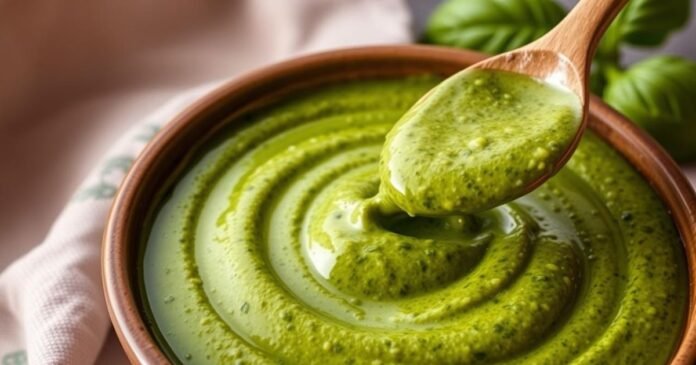Did you know traditional basil pesto uses pine nuts, which can be very expensive? For those with allergies or looking for a cheaper option, there’s a great alternative. You can make a delicious pesto without pine nuts in just 5 minutes with only 5 ingredients.
This recipe makes about 5 servings, each with 7g of protein and 169mg of calcium. You’ll need basil, walnuts, extra virgin olive oil, garlic, and lemon juice. It’s easy and packed with flavor.
Homemade pesto can be kept in the fridge for up to 1 week. You can also freeze it in ice cube trays for up to 6 months. This way, you always have a tasty option ready. Choosing this recipe is not only budget-friendly but also opens up new flavors and creative possibilities in cooking.
Why Choose a Nut-Free Pesto Recipe?
Choosing a nut-free pesto recipe has many benefits. It’s great for saving money or for those with allergies. This pesto is full of flavor and doesn’t cut corners on quality.
Cost-Effectiveness of Walnut Pesto
Walnut pesto is very affordable. Pine nuts, often used in pesto, can be pricey, costing $20 to $30 per pound. Walnuts, on the other hand, are cheaper but just as tasty.
They add a hearty texture and rich flavor to your pesto. Using walnuts makes your pesto delicious and affordable, no matter your budget.
Allergy-Friendly Option
Nut allergies are common, affecting about 1-2% of Americans. Traditional pesto, with pine nuts, can be risky for those with allergies. A nut-free pesto is a safer choice.
It’s perfect for everyone to enjoy without fear. This way, everyone can savor the delicious taste of pesto.
Ingredients You Will Need
To make a tasty nut-free pesto, you’ll need some fresh and top-notch ingredients. These ingredients make sure each batch of pesto is full of flavor. They keep the authentic taste that many people love. Here are the main ingredients you’ll need, along with what they do in the recipe.
Fresh Basil Leaves
Basil is the heart of pesto, giving it a unique flavor. You’ll need 4 cups of fresh basil leaves. Choose leaves that are bright green for the best taste. Fresh basil adds a rich, herbaceous flavor that goes well with the other ingredients.
Extra Virgin Olive Oil
For a smooth and rich pesto, use ½ cup of extra virgin olive oil. This oil holds the ingredients together and adds a peppery, fruity taste. Choose the best extra virgin olive oil you can find for the best flavor.
Garlic and Parmesan Cheese
Garlic adds a spicy kick to the pesto. You’ll need 3 cloves of garlic, finely chopped. Fresh garlic is best for adding depth and complexity. Alongside the garlic, use ¼ cup of freshly grated parmesan cheese, aged over 3 years. This cheese adds a nutty creaminess that makes the pesto savory.
The nutritional profile for these ingredients per serving (¼ cup) is as follows:
| Nutrient | Amount per Serving |
|---|---|
| Calories | 157 kcal |
| Total Fat | 16g |
| Saturated Fat | 3g |
| Cholesterol | 5mg |
| Sodium | 402mg |
| Carbohydrates | 2g |
| Protein | 3g |
Lemon Juice
To balance the pesto’s richness, you’ll need the zest and juice of 1 lemon. The lemon juice adds a bright citrus flavor that cuts through the cheese and oil. It makes the pesto light and refreshing, rounding out the flavors beautifully.
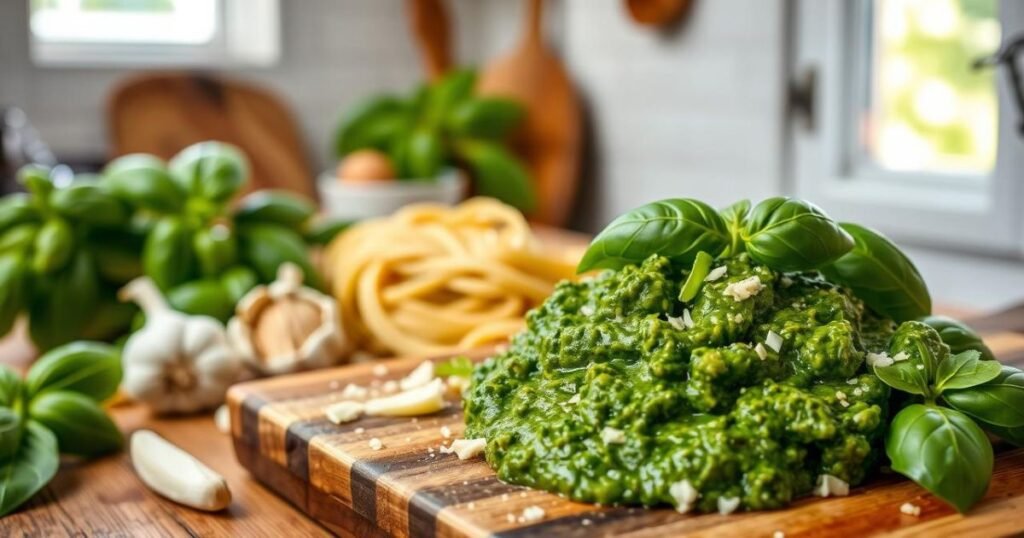
Step-by-Step Guide to Making Pesto Recipe Without Pine Nuts
Making pesto without pine nuts is easy with this guide. It’s great for those who can’t afford pine nuts or have allergies. You can make a batch in just 10 minutes!
- 2 cups fresh basil leaves, de-stemmed and packed
- ½ cup extra virgin olive oil
- ⅓ cup chopped walnuts
- ½ cup grated Parmigiano Reggiano cheese
- 1 tablespoon lemon juice
- 3 garlic cloves
- ¼ teaspoon salt (or to taste)
- ¼ teaspoon black pepper
Instructions:
- First, gather all your ingredients. This makes cooking smoother.
- In a food processor, mix the basil, walnuts, and garlic. Pulse until they’re chopped.
- Add the Parmigiano Reggiano cheese, lemon juice, salt, and black pepper. Pulse to mix well.
- With the processor running, add the olive oil slowly. Blend until smooth but slightly textured.
- Taste and adjust the seasoning if needed. You might want more salt or lemon juice.
- Your pesto is now ready! Use it right away or store it in the fridge for up to a week.
This nut-free pesto is perfect for those on a budget or with dietary restrictions. Feel free to try different ingredients to find your favorite flavor. Enjoy!
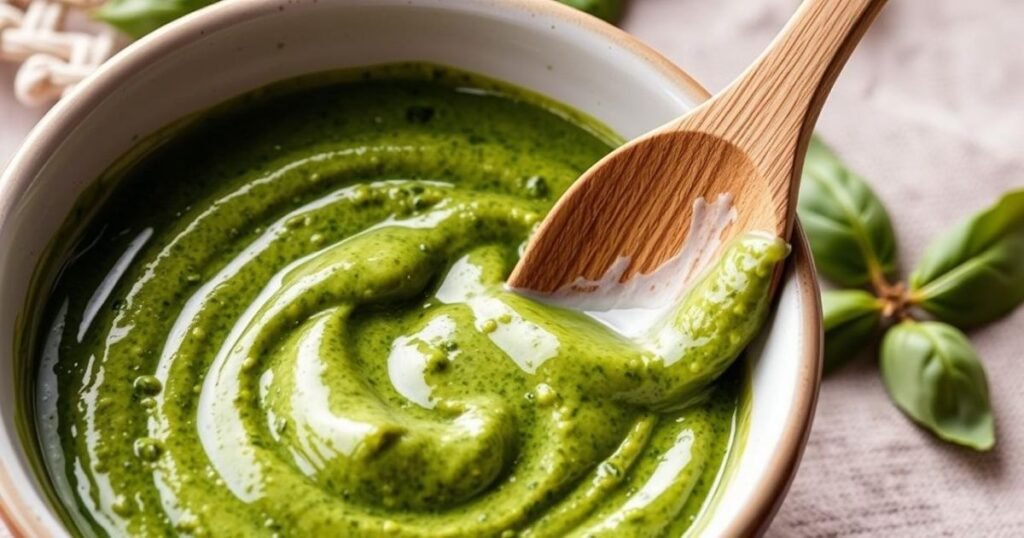
Tips for the Best Homemade Pine Nut-Free Pesto
Making pesto without pine nuts is a tasty and affordable way to enjoy fresh flavors. With a few tips, your pesto will be delicious and full of aroma.
Chop Ingredients Before Blending
Chopping your ingredients before blending is key for smooth pesto. Chop the basil leaves, garlic, and nuts or seeds. This makes blending faster and keeps your pesto’s color and flavor bright.
Chopping is quick. Just chop the basil coarsely and mince the garlic finely.
Quality of Olive Oil
The olive oil you choose greatly affects your pesto’s taste. Always use high-grade extra virgin olive oil for a rich flavor. This recipe needs about ⅓ cup of it.
Good olive oil not only tastes great but also adds healthy fats and antioxidants. This makes your pesto healthier and more delicious.
Storing Your Pesto Properly
Storing your pesto right keeps it fresh and green. Store it in an airtight container in the fridge for up to a week. For longer, freeze it in ice cube trays.
Once frozen, move the cubes to a zip-lock bag. This way, you can keep your pesto for up to three months. It’s always ready to add fresh flavor to your meals.
Variations to Try: Vegan and Dairy-Free Options
I love trying out different pesto variations, like vegan and dairy-free ones. Making a few tweaks to the classic recipe can make a big difference. Here are some ideas to get you started.
Using Nutritional Yeast
Nutritional yeast is a great substitute for parmesan cheese in vegan pesto. It gives a cheesy taste without any dairy. This plant-based ingredient also adds B-vitamins to your pesto.
Substituting Nuts with Seeds
For a pesto with seeds, sunflower or pumpkin seeds are great alternatives to nuts. They add a nice texture and nutty flavor. Plus, they’re good for those with nut allergies and can be cheaper than pine nuts.
Herb Alternatives: Spinach and Arugula
Try using different herbs and greens to change up your pesto’s flavor and nutrition. Spinach pesto and arugula pesto are tasty options. Spinach has a mild taste and lots of iron. Arugula adds a peppery flavor.
Combining these greens with basil can give you a unique pesto. It’s a fun twist on the classic.
| Recipe | Ingredients | Prep Time | Total Time | Servings |
|---|---|---|---|---|
| Vegan Pesto Recipe | ½ cup raw cashews 3 cloves of garlic 2 tablespoons lemon juice ½ cup olive oil 1 cup fresh basil 1 cup fresh baby spinach | 5 minutes | 5 minutes | 4 servings |
| Dairy-Free Pesto Recipe | ½ cup toasted pepitas or sunflower seeds 1 small garlic clove ¼ teaspoon sea salt 2 tablespoons lemon juice ¼ cup olive oil 2 cups fresh basil leaves Optional: 1 tablespoon nutritional yeast | 5 minutes | 5 minutes | 16 servings |
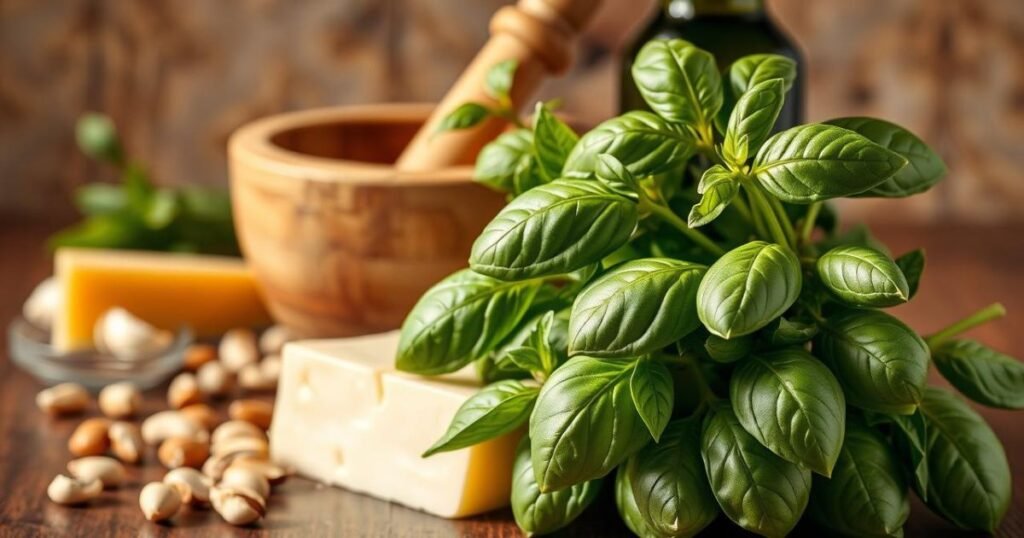
Creative Uses for Your Homemade Pesto
Homemade pesto is more than just for pasta. It can make many everyday meals better. Whether you love pasta or hearty soups, pesto is perfect for your kitchen. Here are some new ways to use this vibrant sauce.
Pasta Dishes
Pesto pasta dishes are a must-try. They let you enjoy the sauce’s rich flavor. Mix it with spaghetti or fusilli for a gourmet meal easily.
Spreading on Sandwiches
Pesto makes sandwiches exciting. Spread it on whole-grain bread, add mozzarella, tomato, and basil. It turns a simple sandwich into a special treat.
Pesto as a Salad Dressing
Using pesto as a salad dressing is a great idea. Mix it with olive oil and lemon juice. It makes any salad, from greens to grain bowls, taste amazing.
Incorporating into Soups and Casseroles
Pesto is also great in soups and casseroles. Add it to minestrone or tomato basil soup for more flavor. It also brightens up baked ziti or vegetable casseroles.
Conclusion
Making pesto without pine nuts opens up new flavors and meets different dietary needs. Homemade pesto is not only affordable and safe for those with allergies. It also lets you add your personal touch to every meal.
With ingredients like fresh basil, extra virgin olive oil, garlic, and Parmesan cheese, your pesto is packed with good stuff. It’s full of healthy fats, vitamins, and antioxidants. This makes it a great addition to a balanced diet.
Making this sauce at home is easy. Just blend your favorite nuts or seeds with basil and olive oil. You’ll get a fresh, tasty sauce for many dishes. You can use walnuts, almonds, or seeds like sunflower and pumpkin.
Plus, homemade pesto keeps well. Store it in the fridge for up to 7 days or freeze it in ice cube trays for months. This makes it handy for future meals.
The uses for homemade pesto without pine nuts are endless. You can mix it into pasta, spread it on sandwiches, or use it as a salad dressing. It’s also great in soups and casseroles. Its versatility and delicious taste make it a must-have in any kitchen.
FAQ – Nut-Free Pesto
What are the benefits of making pesto without pine nuts?
Making pesto without pine nuts can save money and be safe for those with allergies. Using walnuts or seeds makes it cheaper and accessible to more people.
Can walnuts be used as a substitute for pine nuts in pesto?
Yes, walnuts are a great choice. They add a rich flavor and texture similar to pine nuts but are more affordable.
What ingredients are needed for a nut-free pesto recipe?
You’ll need fresh basil, extra virgin olive oil, garlic, parmesan cheese, and lemon juice. Seeds like sunflower or pumpkin can also be used for a nut-free version.
How do I make pesto without pine nuts?
First, chop the ingredients finely. Then, blend them in a food processor. Use fresh basil, garlic, good olive oil, parmesan cheese, and lemon juice for a creamy sauce.
What are some tips for making the best homemade pesto without pine nuts?
Chop ingredients finely before blending. Use high-quality olive oil. Store the pesto well to keep it fresh and vibrant.
Are there vegan and dairy-free alternatives for pesto?
Yes, use nutritional yeast instead of parmesan cheese. Substitute nuts with seeds like sunflower or pumpkin. Try different greens like spinach or arugula for extra flavor and nutrition.
How can I use homemade nut-free pesto in my dishes?
Pesto is versatile. Use it in pasta dishes, on sandwiches, as a salad dressing, or in soups and casseroles for extra flavor.
What is the best way to store homemade pesto?
Store pesto in an airtight container in the fridge. Freezing it in ice cube trays is also a good option for longer storage.
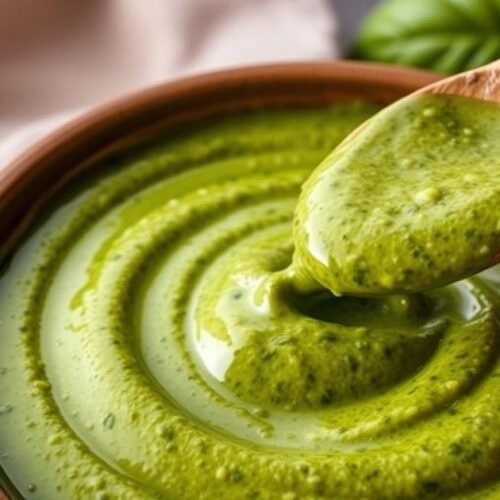
Pesto Recipe Without Pine Nuts
Ingredients
- 2 cups fresh basil leaves de-stemmed and packed
- ½ cup extra virgin olive oil
- ⅓ cup chopped walnuts
- ½ cup grated Parmigiano Reggiano cheese
- 1 tablespoon lemon juice
- 3 garlic cloves
- ¼ teaspoon salt or to taste
- ¼ teaspoon black pepper
Instructions
- Gather all your ingredients.
- In a food processor, mix the basil, walnuts, and garlic. Pulse until they’re chopped.
- Add the Parmigiano Reggiano cheese, lemon juice, salt, and black pepper. Pulse to mix well.
- With the processor running, add the olive oil slowly. Blend until smooth but slightly textured.
- Taste and adjust the seasoning if needed. You might want more salt or lemon juice.
- Your pesto is now ready! Use it right away or store it in the fridge for up to a week.
Notes
- The pesto can be stored in an airtight container in the fridge for up to a week.
- For longer storage, freeze the pesto in ice cube trays. Once frozen, transfer to a zip-lock bag for up to 3 months.
- For a vegan version, use nutritional yeast instead of Parmigiano Reggiano.
- Seeds like sunflower or pumpkin seeds can be substituted for walnuts for a different flavor.
- You can try adding different greens like spinach or arugula for a twist on the classic flavor.

